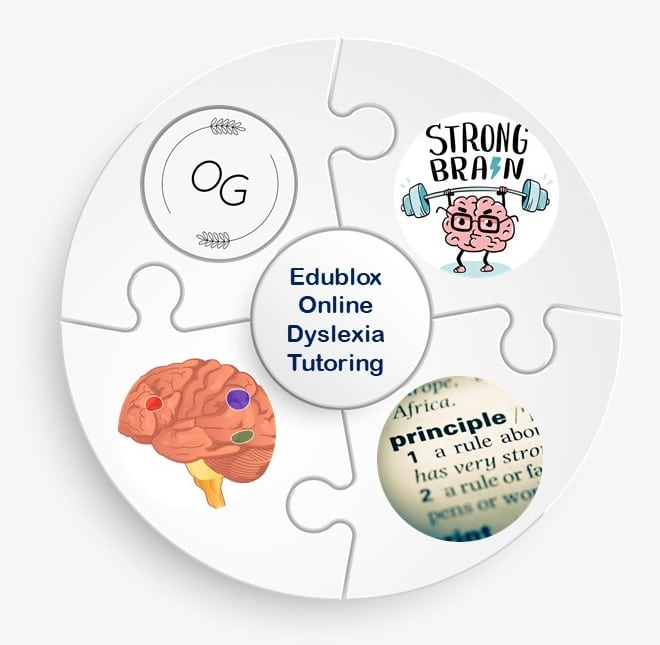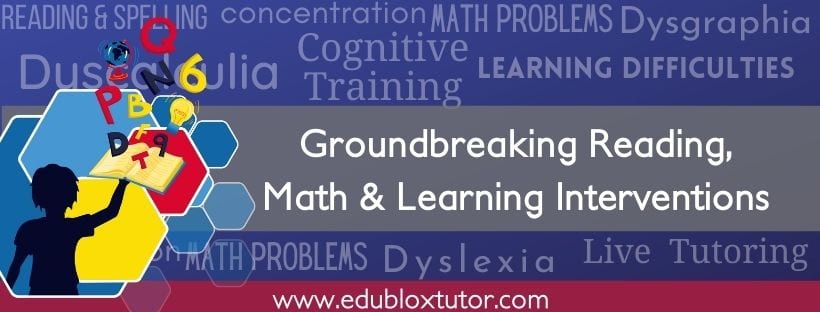
Dyslexia is a learning disability that affects reading and writing skills. According to a Yale study, 1 in 5 people have dyslexia, and 80 to 90 percent of children with learning disabilities are dyslexic. Specialized help is required to treat dyslexia.
Our online dyslexia tutoring services integrate four components: (1.) the Orton-Gillingham approach, (2.) cognitive training, (3.) the development of two crucial brain areas for reading, and (4.) solid learning principles.
Aligned with the Orton-Gillingham approach
The Orton-Gillingham (OG) approach is a direct, explicit, multisensory, structured, sequential, diagnostic, and prescriptive way to teach literacy when reading, writing, and spelling don’t come easily to individuals, such as those with dyslexia. In the hands of a well-trained and experienced instructor, it is a powerful tool of exceptional breadth, depth, and flexibility.
However, research shows some missing pieces in the OG puzzle (Ritchey & Goeke, 2006; Stevens et al., 2021) – pieces that Edublox caters to.
Develops cognitive skills
A core of Edublox intervention is to improve cognitive skills like focused and sustained attention; phonological and phonemic awareness; visuospatial abilities; processing speed and rapid naming; and visual, auditory, sequential, iconic, short-term, and working memory.
Weak cognitive skills prevent a process called orthographic mapping. Every word has three forms: its sounds, spelling, and meaning. The process of orthographic mapping involves the brain linking the three forms of the word and storing them together in long-term memory. It allows for instant word recognition, fluent reading, and accurate spelling..
Targets two crucial brain areas
Research shows that a network of brain regions is involved in learning to read, one specifically in sounding out words and another in seeing words as pictures. The left inferior parietal lobule is said to be involved in word analysis, grapheme-to-phoneme conversion, and general phonological and semantic processing. The picture area is located in the left occipitotemporal region and is known as the visual word form area (VWFA) or visual dictionary (Brem et al., 2020).
Both the sounding out area and the VWFA must be trained in teaching reading. Our online dyslexia tutoring program is based on the Orton-Gillingham approach, which is excellent at developing the sounding out area, but our program simultaneously targets the brain’s VWFA.
Based on fundamental learning principles
Considering that teaching reading is ultimately an educational matter, we should recognize that specific learning principles are involved. It is not just the WHAT of teaching that matters. It is also the HOW.
The application of certain educational learning principles is a core aspect that has so far been overlooked in dyslexia interventions. Thorndike (1874-1949) called learning principles the “laws of learning” and provided a conceptual foundation for how people learn. Edublox’s “laws of learning” in dyslexia intervention consist of fundamental learning principles.
By combining cognitive training with the systematic teaching of reading, while simultaneously applying fundamental learning principles, the way is paved to improve the reading, writing, and learning abilities of children with dyslexia — and even help them completely overcome their challenges.
Online dyslexia tutoring – success stories
Specialized help is required to treat dyslexia. Below are stories of eleven children who received specialized help from Edublox and overcame their dyslexia symptoms.
Our online dyslexia tutoring services are offered to students based in the United States, Canada, Australia, and elsewhere. Book a free consultation to discuss your child’s learning needs..
References:
Brem, S., Maurer, U., Kronbichler, M. et al. (2020). Visual word form processing deficits driven by severity of reading impairments in children with developmental dyslexia. Scientific Reports, 10.
Ritchey, K. D., & Goeke, J. L. (2006). Orton-Gillingham and Orton-Gillingham-based reading instruction: A review of the literature. The Journal of Special Education, 40(3): 171–183.
Shaywitz, S. E., Holahan, J. M., Kenney, B. et al. (2020). The Yale outcome study: Outcomes for graduates with and without dyslexia. Journal of Pediatric Neuropsychology, 6: 189–97.
Stevens, E. A., Austin, C., Moore, C. et al. (2021). State of the evidence: Examining the effects of Orton-Gillingham reading interventions for students with or at risk for word-level reading disabilities. Exceptional Children, 87(4): 397-417.

